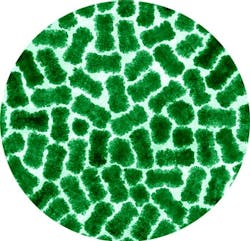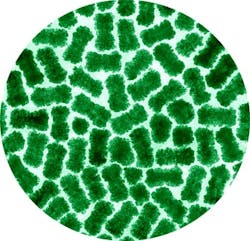Nanorod Catalysts Promise Pluses
Researchers at Rice University, Houston, recently created polymer-coated bimetallic catalysts that are soluble in organic solvents. Their hybrid organic/inorganic structure should offer advantages for making materials such as pharmaceuticals, explains Eugene Zubarev, an associate professor of chemistry.
"There are some industrial reactions where drug makers have no choice but to use platinum and palladium catalysts, but the majority of these are homogeneous, which means they mix readily with reactants and are very difficult to remove," he notes. "Because these heavy metals are toxic, they must be completely removed from the drug after its synthesis is completed. However, the removal of homogeneous catalysts is very time consuming and expensive, which creates a big problem for pharmaceutical companies."
The Rice researchers previously had found that coating gold nanorods with platinum could enhance platinum's catalytic effect. However, such bimetallic nanorods are only soluble in water, not organic solvents, which limits their applicability.
To address this issue, Zubarev and graduate student Bishnu Khanal attached hairlike molecules of polystyrene to the nanorods (Figure 1). The polystyrene shells made the coated particles completely soluble in organic solvents and dramatically enhanced their selectivity. (More details appear in Angewande Chemie International Edition.) A conventional centrifuge can remove the particles easily from solution.
"The selectivity of the coated gold and platinum nanorods will be very attractive to industry," Zubarev contends. "For example, we found they had nearly 100% catalytic selectivity for the hydrogenation of terminal olefins." He sees the catalysts as particularly promising for hydrogenation and hydrogenolysis. "These are the most common reactions where platinum- and palladium-based catalysts are used," he notes.
"We also expect the nanorods to be more resistant to poisoning. This enhanced stability is normally observed in bimetallic systems when compared to pure metal catalysts," he adds.
However, the materials currently have downsides. They are expensive; reducing their cost may be essential for eventual industrial use. Also, their selectivity comes at the price of longer time to catalyze reactions than regular catalysts.
Early next year the researchers aim to start work on enantioselectivity. "It would be a really big step forward if we could make our catalyst enantioselective. This… would certainly offer a great help in the synthesis of many drugs. The idea we plan to explore is to use rigid chiral molecules instead of polystyrene chains on the surface of these bimetallic nanorods, which would hopefully make them capable of converting prochiral molecules into just one, or primarily one, type of enantiomer," Zubarev explains.
Researchers also are working on palladium-coated gold nanorods. "The early indications are very promising," Zubarev says.

